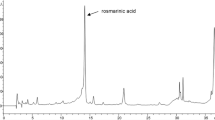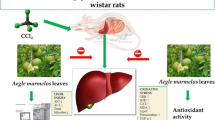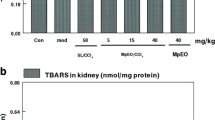Abstract
The objective of the present study was to investigate the hepatoprotective effects of methanol extract of Meconopsis aculeata, an important medicinal plant of Kashmir Himalayas, against CCl4 induced oxidative damage in rats. Acute hepatotoxicity was induced in Wistar albino rats by single intraperitoneal injection of CCl4 at 1 ml/kg body weight dose. Methanol extract of M. aculeata was orally administered at the doses of 100, 200 and 300 mg/kg body weight/day for 14 days. The results revealed that administration of CCl4 caused a significant increase in serum AST, ALT and LDH levels as compared to the control group (p < 0.001). Additionally, there was a significant decrease in the level of hepatic GSH, GPx, GST, SOD and CAT activities associated with a significant increase of MDA content in CCl4 treated group compared to those of the control group. However, the treatment with methanol extract of M. aculeata prevented these alterations and maintained the antioxidant status. The hepatoprotective property of the extract was further confirmed by histopathological analysis, wherein the extract was shown to prevent neutrophil infiltration and tissue necrosis in the liver samples of treated animals. The results of the present investigation indicate that methanol extract of M. aculeata possesses potent hepatoprotective activity, possibly due to its antioxidant properties.



Similar content being viewed by others
References
Beauchamp C, Fridovich I (1971) Superoxide dismutase; improved assays and an assay applicable to acrylamide gel. Anal Biochem 44:276–287
Claiborne A (1985) Catalase activity. Handbook of methods of oxygen radical’s research. CRC Press, Boca Raton, p 283
Cook NC, Samman S (1996) Flavonoids—chemistry, metabolism, cardioprotective effects, and dietary sources. J Nutr Biochem 7:66–76
Ganie SA, Zargar BA, Masood A, Zargar MA (2013) Hepatoprotective and antioxidant activity of rhizome of Podophyllum hexandrum against Carbon Tetra Chloride induced hepatotoxicity in rats. Biomed Environ Sci 26:209–221
Glantzounis GK, Tsimoyiannis EC, Kappas AM, Galaris DA (2005) Uric acid and oxidative stress. Curr Pharm Des 11:4145–4151
Halliwell B, Gutteridge JMC (1992) Free radicals antioxidants and human diseases. Lab Clin Med 119:598–620
Haque R, Bin HB, Parvez S, Pandey S, Sayeed I, Ali M, Raisuddin S (2003) Aqueous extract of walnut protects mice against cyclophosphamide induced biochemical toxicity. Hum Exp Toxicol 22:473–480
Hassan S, Sajjad N, Ali R, Ganie SA, Hamid R (2018) In vitro antioxidant potential of various extracts of Meconopsis aculeata. Int J Adv Res Sci Eng 7:1984–1995
Hsouna AB, Trigui M, Culioli G, Blache Y, Jaoua S (2011) Antioxidant constituents from Lawsonia inermis leaves: isolation, structure elucidation and antioxidative capacity. Food Chem 125:193–200
Jewell SA, Di Monte D, Richelmi P, Bellomo G, Orrenius S (1986) Tert-butyl hydroperoxide-induced toxicity in isolated hepatocytes: contribution of thiol oxidation and lipid peroxidation. J Biochem Toxicol 1:13–22
King J (1965) The dehydrogenase or oxidoreductase-lactate dehydrogenase. Practical clinical enzymology. Nostrand Co., London, p 93
Ko KM, Ip SP, Poon MK, Wu SS, Che CT, Ng KH, Kong YC (1995) Effect of a lignin enriched Fructus schisandrae extract on hepatic glutathione status in rats: protection against carbon tetrachloride toxicity. Planta Med 61:134–137
Krishnaiah D, Sarbatly R, Nithyanandam R (2011) A review of the antioxidant potential of medicinal plant species. Food Bioprod Process 89:217–233
Laouar A, Klibet F, Bourogaa E, Benamara A, Boumendjel A, Azzedine C, Messarah M (2017) Potential antioxidant properties and hepatoprotective effects of Juniperus phoenicea berries against CCl4 induced hepatic damage in rats. Asian Pac J Trop Med 10:263–269
Lowry OH, Rosenbrough NJ, Farr AI, Randall RJ (1951) Protein estimation with the Folin phenol reagent. J Biol Chem 193:265–275
Mitra SK, Venkataranganna MV, Sundaram R, Gopumadhavan S (1998) Protective effect of HD-03 a herbal formulation against various hepatotoxic agents in rats. J Ethnopharmacol 63:181–186
Moren MA, Depierre JW, Mannervick B (1979) Levels of glutathione glutathione reductase and glutathione S-transferase activities in rat lung and liver. Biochem Biophys Acta 582:67–78
Mudasar A, Kaloo ZA, Ganai BA, Ganaie HA, Singh S (2016) Phytochemical screening of Meconopsis aculeata Royle-an important medicinal plant of Kashmir Himalaya: a perspective. Res J Phytochem 10:1–9
Nichans WG, Samuelson D (1968) Formation of malondialdehyde from phospholipid arachidonate during microsomal lipid peroxidation. Eur J Biochem 6:126–130
Noguchi T, Fong KL, Lai EK, Alexander SS, King MM (1982) Specificity of a phenobarbital-induced cytochrome P450 for metabolism of carbon tetrachloride to the trichloromethyl radical. Biochem Pharmacol 31:615–624
Packer JE, Slater TF, Willson RL (1978) Reactions of the carbon tetrachloride related peroxy free radical with amino acids; pulse radiolysis evidence. Life Sci 23:2617–2620
Poeggeler B (2005) Melatonin, aging and age-related diseases: perspectives for prevention, intervention and therapy. Endocrine 27:201–212
Ranawat L, Bhatt J, Patel J (2010) Hepatoprotective activity of ethanolic extracts of bark of Zanthoxylum armatum DC in CCl4 induced hepatic damage in rats. J Ethnopharmacol 127:777–780
Ravipati AS, Zhang L, Koyyalamudi SR, Jeong SC, Reddy N, Bartlett J, Smith PT, Shanmugam K, Münch G, Wu MJ, Satyanarayanan M, Vysetti B (2012) Antioxidant and anti-inflammatory activities of selected Chinese medicinal plants and their relation with antioxidant content. BMC Complement Altern Med 12:173
Reitman S, Frankel AS (1975) A colorimetric method for the determination of serum glutamic oxaloacetic and glutamic pyruvic transaminases. Am J Clin Pathol 28:56–63
Rinchen T, Pant S (2014) Ethnopharmacological uses of plants among inhabitants surrounding Suru and Zanskar, Valleys of cold desert, Ladakh. Int J Pharma Biosci 5:486–494
Rubinstein D (1962) Epinephrine release and liver glycogen levels after carbon tetrachloride administration. Am J Physiol 203:1033–1037
Scalbert A, Manach C, Morand C, Remesy C, Jimenez L (2005) Dietary polyphenols and the prevention of diseases. Crit Rev Food Sci Nutr 45:287–306
Sharma N, Trikha P, Athar M, Raisuddin S (2001) Inhibition of benzo pyrene and cyclophosphamide-induced mutagenicity by cinnamomum cassia. Mutat Res 480–481:179–188
Sheweita SA, EI-Gabar MA, Bastawy M (2001) Carbon tetrachloride changes the activity of cytochrome P450 system in the liver of male rats: role of antioxidants. Toxicology 169:83–92
Srivastava A, Shivanandappa T (2010) Hepatoprotective effect of the root extract of Decalepis hamiltonii against carbon tetrachloride-induced oxidative stress in rats. Food Chem 118:411–417
Suja SR, Latha PG, Pushpangadan P, Rajasekharan S (2004) Evaluation of hepatoprotective effects of Helminthostachys zeylanica (L.) Hook against carbon tetrachloride-induced liver damage in Wistar rats. J Ethnopharmacol 92:61–66
Sureshkumar SV, Mishra SH (2006) Hepatoprotective effect of extracts from Pergularia daemia Forsk. J Ethnopharmacol 107:164–168
Tandon VR, Verma S, Singh J, Mahajan A (2005) Antioxidants and cardiovascular health. J Med Educ Res 7:115–118
Tsarong TJ (1994) Tibetan medicinal plants. Tibetan Medical Publications, Kalimpong, p 1
Umamaheswari M, Chatterjee TK (2008) In vitro antioxidant activities of the fractions of Coccinia Grandis leaf extract. Afr J Tradit Complement Altern Med 5:61–73
Wang CJ, Wang JM, Lin WL, Chu CY, Chou FP, Tseng TH (2000) Protective effect of Hibiscus anthocyanins against tert-butyl hydroperoxide-induced hepatic toxicity in rats. Food Chem Toxicol 38:411–416
Weber LW, Boll M, Stampfl A (2003) Hepatotoxicity and mechanism of action of haloalkanes: carbon tetrachloride as a toxicological model. Crit Rev Toxicol 33:105–136
Zimmerman HJ, Seeff LB (1970) Enzymes in hepatic disease. Diagnostic enzymology. Lea and Febiger, Philadelphia, p 233
Acknowledgements
The authors would like to acknowledge Department of Biochemistry (DST-FIST assisted), University of Kashmir for providing all the necessary facilities throughout this study. This study was not supported by any funding agency.
Author information
Authors and Affiliations
Corresponding authors
Ethics declarations
Ethical statement
The procedures performed in this study were carried in accordance with the ethical standards of the Animal Ethics Committee, University of Kashmir, Srinagar and approved under registration No. KU/2015/07, dated 21-08-2015.
Conflict of interest
Sumaya Hassan has no conflict of interest. Muzaffar Ahmad Bhat has no conflict of interest. Nasreena Sajjad has no conflict of interest. Rohaya Ali has no conflict of interest. Showkat Ahmad Ganie has no conflict of interest. Rabia Hamid has no conflict of interest.
Additional information
Publisher's Note
Springer Nature remains neutral with regard to jurisdictional claims in published maps and institutional affiliations.
Rights and permissions
About this article
Cite this article
Hassan, S., Bhat, M.A., Sajjad, N. et al. Hepatoprotective effects of Meconopsis aculeata extract against CCl4 induced oxidative damage in rats. ADV TRADIT MED (ADTM) 20, 545–554 (2020). https://doi.org/10.1007/s13596-020-00490-2
Received:
Accepted:
Published:
Issue Date:
DOI: https://doi.org/10.1007/s13596-020-00490-2




